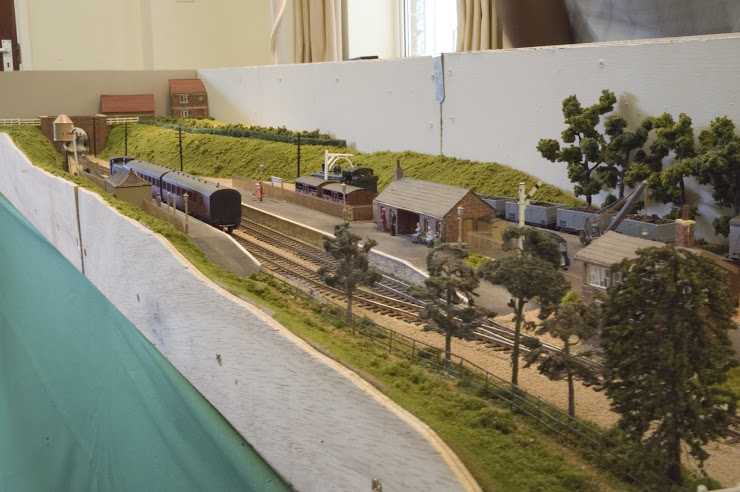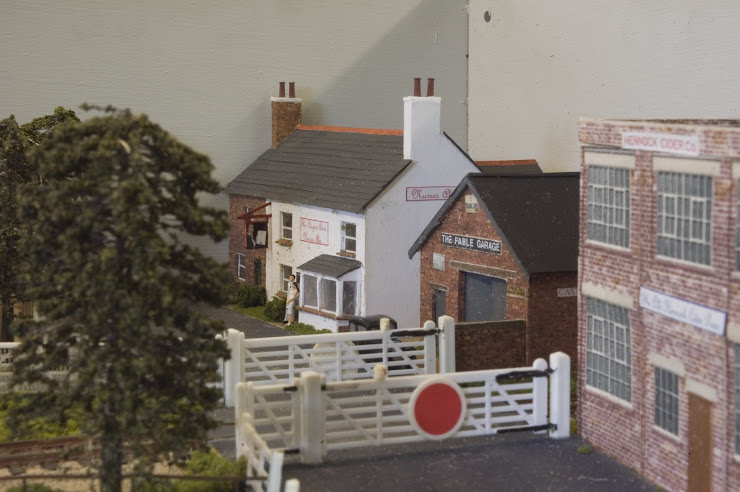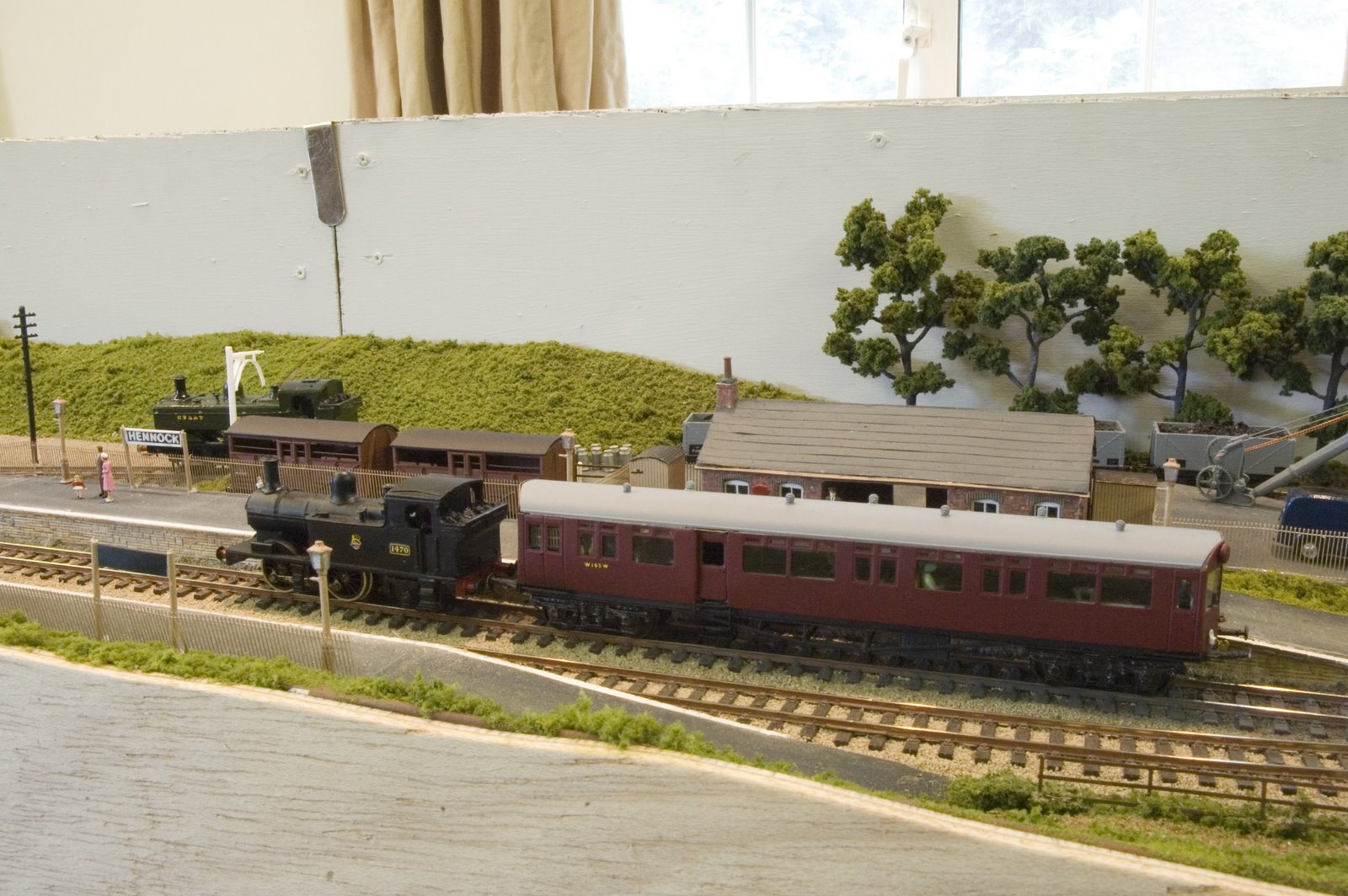Nigel has been very busy with the Pannier body.
Using a footplate from a damaged Pannier body he has married the two together. The use of a whitemetal footplate gives strength and weight as the body is extremely light.
The castings are from a 57XX kit with the chimney and dome modified to suit the flat topped pannier tank.
The chassis is a Brynkits fold up type fitted with Romford wheels and Branchlines Mashima 9/16 motor and 40:1 single stage gearbox.
I think that as the project gathers pace, a very good model of the chosen prototype will be produced.
Hennock

General view of Layout.The facia has since been varnished.
The Degree Inn

In recognition of my eldest Daughter's achievement. She is also the one who gave me the push to build the layout.
14XX and Autocoach

Shows Station building-based on Staverton.
Hennock Track Plan

Monday, July 30, 2012
Saturday, July 28, 2012
Rapid Prototyping.
A further ammendment to the bodies, removing the smokebox door and reinstatement of the firebox above tank level has resulted in some further efforts.
As an experiment four bodies were produced to see if multiples could be made.
These were produced in white plastic this time and show that a more refined body can be made.
Two of each type were made and it is apparent from these that a knowledge of computer programming and systems is probably of more importance than a knowledge of railway engines.
As an experiment four bodies were produced to see if multiples could be made.
These were produced in white plastic this time and show that a more refined body can be made.
Two of each type were made and it is apparent from these that a knowledge of computer programming and systems is probably of more importance than a knowledge of railway engines.
Thursday, July 26, 2012
Mixed Traffic July 2012.
It never ceases to amaze me- the diversity of models that have been created in 3mm Scale.
In this quarters Mixed Traffic we have a Hogwarts Hall by Steve Spells, Peter Bossom going all nuclear, Billton Goods- a layout from Tony Briddon Victor Hall adapting a Tri-ang Medfit body to a Fencehouses chassis and Addison Mk 2 from Phill Hutchings. Addison Park brings back memories of Trollybusses and Metropolitan Bo-Bo locos in the metropolis- a superb piece of nostalgia.
Add in the prizewinners at the 2012 AGM and blastpipe, Q&A and Bits n Pieces and yet another reason to subscribe to the 3MM Society has been published!
In this quarters Mixed Traffic we have a Hogwarts Hall by Steve Spells, Peter Bossom going all nuclear, Billton Goods- a layout from Tony Briddon Victor Hall adapting a Tri-ang Medfit body to a Fencehouses chassis and Addison Mk 2 from Phill Hutchings. Addison Park brings back memories of Trollybusses and Metropolitan Bo-Bo locos in the metropolis- a superb piece of nostalgia.
Add in the prizewinners at the 2012 AGM and blastpipe, Q&A and Bits n Pieces and yet another reason to subscribe to the 3MM Society has been published!
Tuesday, July 24, 2012
Rapid Prototyping.
This shows the formation of the body produced.
This actually happened because of a power cut during the process.
A mat is weaved and the item is produced on top of the initial matrix.
I am very impressed with the bodies that have been created and would urge the doubters to have a go. As I understand it the machine costs around £1000 plus the software costs making the result an extremely affordable proposition for short run production.
More later.
This actually happened because of a power cut during the process.
A mat is weaved and the item is produced on top of the initial matrix.
I am very impressed with the bodies that have been created and would urge the doubters to have a go. As I understand it the machine costs around £1000 plus the software costs making the result an extremely affordable proposition for short run production.
More later.
Sunday, July 22, 2012
Dorset Group Meeting 21st July 2012.
This very nice man (Once you got to know him) gave a splendid presentation to us in the summary surroundings of our home at the former Hurn Railway Station in sunny East Dorset. They say that the sun shines on the righteous- well, we must have been good today!
Explaining the materials and the methods he uses, Jeff gave an excellent talk about his products and many useful tips regarding paints and card that are his preferred materials.
Jeff is a driver for Railfreight and many entertaining stories kept us all entertained for all of the meeting.
Pictured are a fraction of the designs produced and we may have persuaded him to consider some in 3mm.
Jeff Weston can be contacted by e-mail at jeff283@btinternet.com
More of his creations can be seen on Ebay under N gauge buildings.

Explaining the materials and the methods he uses, Jeff gave an excellent talk about his products and many useful tips regarding paints and card that are his preferred materials.
Jeff is a driver for Railfreight and many entertaining stories kept us all entertained for all of the meeting.
Pictured are a fraction of the designs produced and we may have persuaded him to consider some in 3mm.
Jeff Weston can be contacted by e-mail at jeff283@btinternet.com
More of his creations can be seen on Ebay under N gauge buildings.

Saturday, July 21, 2012
Alignment.
It is difficult to show the baseboard alignment method I use. Basically a male fits a female - brass turnings which fit into 8mm holes drilled in the ends of boards which have been clamped together hopefully in the right position!
The snug fit makes sure that the boards fit in the right place every time.
Moving to fiddleyard tracks being held in the correct place- I use square brass tube with a solid square bar which fits snugly.
Bent at the end and used as a simple bolt which makes each trach align with its intended route.
 |
| The bolt also gives electrical connection to the intended route. |
Thursday, July 19, 2012
Track and Fiddle Yard.
At last the track and fiddle yard board are complete.
A couple more pieces of 9mm ply have been turned into baseboards and the fiddle yard curve cut.
To keep the Fiddle board square I have screwed a couple of pieces of aluminium angle to each edge-this should keep it flat!
At the end a piece of sponge rubber has been secured with yet more angle which should prevent disasterous runaways.
Next time I hope to show how the boards are kept in the correct position and the fiddleyard tracks aligned.
A couple more pieces of 9mm ply have been turned into baseboards and the fiddle yard curve cut.
To keep the Fiddle board square I have screwed a couple of pieces of aluminium angle to each edge-this should keep it flat!
At the end a piece of sponge rubber has been secured with yet more angle which should prevent disasterous runaways.
Next time I hope to show how the boards are kept in the correct position and the fiddleyard tracks aligned.
Tuesday, July 17, 2012
We all need support!
I have always attached the legs to all of my previous layouts and I see no reason to change.
Liking to keep things simple, a method of keeping the legs in place is one that I came across quite by accident a long time ago.
With the legs attached by hinges to the end of each board- one board has two- a way of keeping them in position was considered. Enter the humble screw block available from most DIY outlets at very reasonable cost- these are the things that keep flat pack furniture hopefully at right angles and therefore square.
An elongated Z shaped bar is produced with 3mm diameter rod which has each end bent to a right angle, preferably in the same plane!
These rods are them simply inserted into the blocks which keep the whole lot upright and rigid.
There- said it was simple.
Liking to keep things simple, a method of keeping the legs in place is one that I came across quite by accident a long time ago.
With the legs attached by hinges to the end of each board- one board has two- a way of keeping them in position was considered. Enter the humble screw block available from most DIY outlets at very reasonable cost- these are the things that keep flat pack furniture hopefully at right angles and therefore square.
An elongated Z shaped bar is produced with 3mm diameter rod which has each end bent to a right angle, preferably in the same plane!
These rods are them simply inserted into the blocks which keep the whole lot upright and rigid.
There- said it was simple.
Sunday, July 15, 2012
Rapid Prototyping.
Two bodies for Panniers have been produced, a 64XX and an early 57XX.
Subsequent pictures will show that some work has to be done to the raw moulding as due to the body being built up in layers, a corrugated effect is evident. Bear in mind that the engineers have only recently obtained the machine and these are early examples. It may well be that ,with experience, a better result will be obtained.
More later- comments are welcome but it must be stated that this will not be a commercial venture at this time.Please see my amendment to the first Rapid Prototype post- The measurements were actually used to produce a 3D drawing- not a scanned drawing as I had said.
Subsequent pictures will show that some work has to be done to the raw moulding as due to the body being built up in layers, a corrugated effect is evident. Bear in mind that the engineers have only recently obtained the machine and these are early examples. It may well be that ,with experience, a better result will be obtained.
More later- comments are welcome but it must be stated that this will not be a commercial venture at this time.Please see my amendment to the first Rapid Prototype post- The measurements were actually used to produce a 3D drawing- not a scanned drawing as I had said.
Saturday, July 14, 2012
Rapid Prototyping
Bodies and chassis of the 54XX Pannier Tank will both be seen at the next Dorset Railway Modelling Group meeting on the 21st July.Interest seems to be there and further updates will be posted shortly.
Friday, July 13, 2012
Rapid Prototyping
New technology is really getting to the point that we can have anything we want in the time it takes to scan a drawing into a computer.
One of our group members, Nigel, has taken the opportunity of a project at his place of work to put this theory to the test.
Taking drawings published in an elderly edition of Mixed Traffic these were measured transferred to a 3D programme and transfered to a SD card. The card was inserted into a machine which heats plastic to about 200 degrees and produces a solid copy in layers of .2mm.
As can be seen, the result matches exactly to the drawing. More later!
One of our group members, Nigel, has taken the opportunity of a project at his place of work to put this theory to the test.
Taking drawings published in an elderly edition of Mixed Traffic these were measured transferred to a 3D programme and transfered to a SD card. The card was inserted into a machine which heats plastic to about 200 degrees and produces a solid copy in layers of .2mm.
As can be seen, the result matches exactly to the drawing. More later!
Tuesday, July 10, 2012
Dorset Modelling Society Meeting July 21st.
Some time ago I waxed lyrical about the products of Jeff Weston who is the brains behind Modern Image Models.
At the time I mentioned that the bricks scaled at almost 3mm scale and so impressed I passed a sample onto John Sutton, the editor of the 3mm Society's Mixed Traffic for appraisal.
The Good news is that Jeff has agreed to visit us during our next meeting-Saturday July 21st- starts at 1pm, for a talk and practical demo of his products.
Our meeting place as usual is-
The Pullman Coach,
Avon Causeway Hotel,
Hurn,
Christchurch
Dorset BH23 6AS.
At the time I mentioned that the bricks scaled at almost 3mm scale and so impressed I passed a sample onto John Sutton, the editor of the 3mm Society's Mixed Traffic for appraisal.
The Good news is that Jeff has agreed to visit us during our next meeting-Saturday July 21st- starts at 1pm, for a talk and practical demo of his products.
Our meeting place as usual is-
The Pullman Coach,
Avon Causeway Hotel,
Hurn,
Christchurch
Dorset BH23 6AS.
Thursday, July 05, 2012
Worsley Works M7.
Part of the reason that I bought the Hornby Push-Pull set was so that it would aid me creating the same in 3mm scale.
At long last the chassis was made during our June Dorset Group meeting.
The chassis from Worsley is etched in nickle silver and is a quality etch. The axle holes were opened out with a broach and straw hat bearings soldered in place. the chassis was bentup and a couple of spots of solder applied to keep it all square.Wheels are Markits 16.5 mm drivers available from the Society Shop. The motor, a Mashima 9/16 with 40:1 single stage gearbox is from Branchlines. Power has been applied and all seems to work OK. A session on the rolling road with a good oiling should ensure that it is well run in ready for the bogie and body.
At long last the chassis was made during our June Dorset Group meeting.
The chassis from Worsley is etched in nickle silver and is a quality etch. The axle holes were opened out with a broach and straw hat bearings soldered in place. the chassis was bentup and a couple of spots of solder applied to keep it all square.Wheels are Markits 16.5 mm drivers available from the Society Shop. The motor, a Mashima 9/16 with 40:1 single stage gearbox is from Branchlines. Power has been applied and all seems to work OK. A session on the rolling road with a good oiling should ensure that it is well run in ready for the bogie and body.
Tuesday, July 03, 2012
Another 3mm Layout.
Robert has gone large.
A new layout that is not Micro-sized.
No name as yet but progress is being made and the initial results are very promising.
Two boards this time with hand built points.
The tunnel is an extended 2mm scale product which shows how adaptable us 3millers can be.
A new layout that is not Micro-sized.
No name as yet but progress is being made and the initial results are very promising.
Two boards this time with hand built points.
The tunnel is an extended 2mm scale product which shows how adaptable us 3millers can be.
Sunday, July 01, 2012
Modifying Tri-ang Class 31.
Peter has been converting stock to run on 14.2 mm track for a while.
However, he has recently started rewheeling the Tri-ang TT Class 31.
As can be seen, he has removed the original 12mm wheels from the nylon axles and substituted them for finer treaded ones.
The lower photo shows the improvement this brings but the problem of keeping the wheels square is proving somewhat of a problem.
I am sure he will keep at it and that a solution will be found.
However, he has recently started rewheeling the Tri-ang TT Class 31.
As can be seen, he has removed the original 12mm wheels from the nylon axles and substituted them for finer treaded ones.
The lower photo shows the improvement this brings but the problem of keeping the wheels square is proving somewhat of a problem.
I am sure he will keep at it and that a solution will be found.
Subscribe to:
Posts (Atom)




































